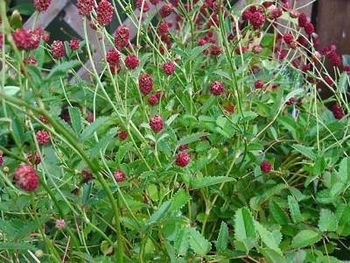Difference between revisions of "Greater Burnet"
| Line 1: | Line 1: | ||
[[File:Burnet.jpg|thumb|350px|left|Greater Burnet]] | [[File:Burnet.jpg|thumb|350px|left|Greater Burnet]] | ||
| − | Other Names: | + | Other Names: Grand Burnet, Pimpinela Mayor, Poterium officinale, Sanguisorba, Sanguisorba carnea, Sanguisorba officinalis, Sanguisorba polygama, Zi Yu.<br>Greater burnet is a plant. Great burnet is a perennial of the rose family (Rosaceae) that can reach between 30 and 90 cm in height. The plant has a coarse primary root and dark brown, short rhizomes. The rhizomes give rise to branched flower stalks. The leaves are blue-green and heart-shaped.The rhizomes, roots and the fresh or dried aerial parts of the herbs have been used in herbal medicine.<br>See also : |
* [[Lesser Burnet]] | * [[Lesser Burnet]] | ||
* [[Salad Burnet]] | * [[Salad Burnet]] | ||
Latest revision as of 10:28, 29 June 2018
Other Names: Grand Burnet, Pimpinela Mayor, Poterium officinale, Sanguisorba, Sanguisorba carnea, Sanguisorba officinalis, Sanguisorba polygama, Zi Yu.
Greater burnet is a plant. Great burnet is a perennial of the rose family (Rosaceae) that can reach between 30 and 90 cm in height. The plant has a coarse primary root and dark brown, short rhizomes. The rhizomes give rise to branched flower stalks. The leaves are blue-green and heart-shaped.The rhizomes, roots and the fresh or dried aerial parts of the herbs have been used in herbal medicine.
See also :
Special Precautions of Greater Burnet
Because of the high content of tannins the herb should not be used continuously over a long time.
Benefits and uses of Greater Burnet are
The main substances found in great burnet are flavonoids, saponins, ursolic acid, arabinose, essential oil, vitamin C, and tannins. The scientific name Sanguisorba refers to the herbs medicinal properties where “anguis” means blood and “sorb” means “to suck up”. For centuries the plant has mostly been used as a hemostatic agent both in Western and Chinese herbal medicine. In both Chinese and Western herbal medicine a decoction of the root has been used internally for heavy menstrual bleeding, blood in stool and urine, bleeding hemorrhoids and uterine bleeding.
- Heavy menstrual flow during menopause.
- Hot flashes.
- Irregular menstrual flow
- Diarrhea.
- Ulcerative colitis.
- Hemorrhoids.
- Bladder problems.
- Varicose veins.
- Wounds and boils, when applied to the skin as a plaster.
- A mouthwash can be made from the herb and used as an herbal treatment for gum inflammation and swollen tonsils.
- Great burnet has demonstrated in vitro an inhibitory effect on many pathogenic bacteria such as Staphylococcus aureus, Streptococcus pneumoniae and Pseudomonas aeruginosa.
- To treat burns, the powdered root can be blended with sesame oil and then applied to the affected areas.
